(Written by Mark H. Avery)
Like lots of other people, the Coronavirus has changed by life. Thank G-d I am healthy, but I’ve been self- quarantined for weeks. I still have my job, but I seem to be working a lot harder at it than usual. But like, I assume, many others, I’m looking for things to do.

That brings me to LEGO – and for ideas of what to build. I’m somewhat scared of buying individual bricks or pieces on places like BrickLink.com because of the virus, so it means using what I have. (And I never have enough windows.) But honestly, I’m not big on purchasing big bulk orders online. It’s expensive, and to me feels a little like cheating.
LEGO CITY PLANNING – INTRODUCTION
Out of boredom, I decided to look through some of my old collection of model train magazines for LEGO city/train ideas – and to share those ideas with readers here. (Please see links for my previous two-part series on the subject at the end of this article.) This time I decided to be a little more specific with some of my ideas, and to clearly cite my sources, so you can do some exploratory reading on your own.

A word about those sources. Model Railroader (MR), published by Kalmbach Media, is the leading magazine in its (HO and N scaled) field. Its companion magazine, Classic Toy Trains (CTT) focuses on larger scale models, referred to as O and S scales. O is fairly close to LEGO train/minifigure scale. Each issue of both magazines includes visits to at least two layouts, several ‘how-to’ articles, reviews of new products and much more – including advertisements that offer great pictures. Just studying some of the layout pictures they publish should give you ideas.
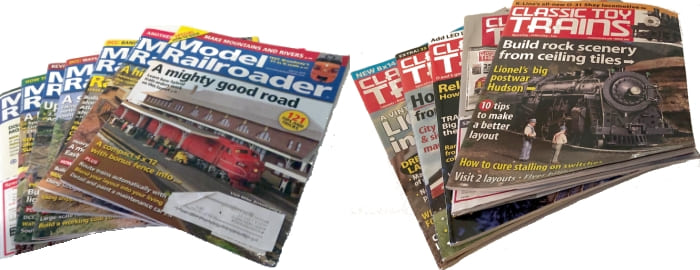
The same company publishes two annual magazines (Great MR and MR Planning) and several books and special issues each year. If you want other similar sources, look online for Carsten Publications and for O Gauge Railroading. I randomly started looking through MR magazines from 2010 and then 2009. Mixed in are ideas from other magazines and my own ideas, as well as concepts that come from old LEGO Catalogs. (These magazines also have websites and sell downloadable collections of articles on different topics.) Turning pages in the last thirty years of LEGO Catalogs will yield equally good ideas. When is the last time you looked at an old LEGO Idea Book? Below, I offer ideas broken into different categories, all meant as ideas for those into LEGO city and/or trains.
DON’T FINISH THAT WORK
I came across this fascinating little article about a couple that ran out of time as they were preparing for a public show of their HO 28 by 55 foot layout(MR, January, 2010). A LEGO layout that had the same coverage would be about 60 by 120 feet, a very large undertaking. They wanted to construct a chainlink fence around a plumbing supply shed but didn’t have time. Instead, they left several rolls of fencing on the ground with one roll in the pickup truck parked in the driveway and several workers preparing to install the fence. In their words, “…the static effect of a finished fence is thus replaced by a sense of activity that adds a bit of life to the scene…” (Page 52). All, sort of, by accident, but a great lesson for LEGO builders.
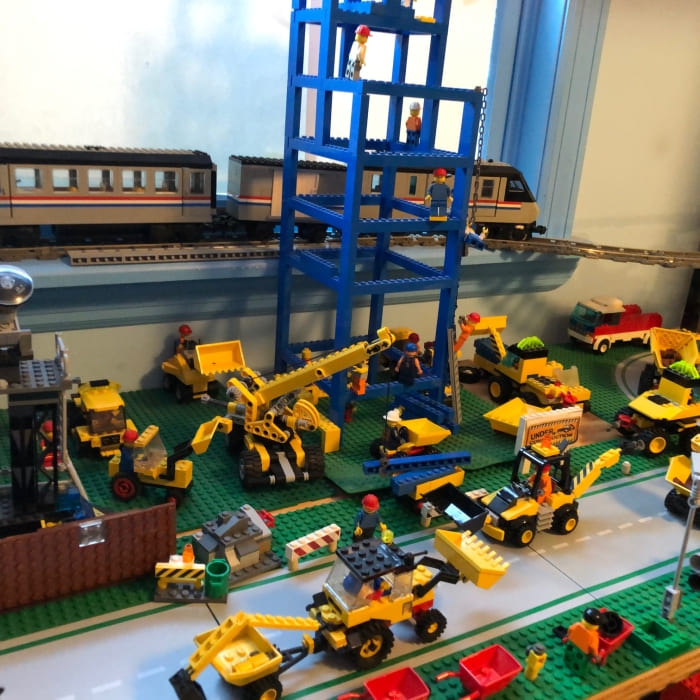
The same couple were building a supermarket when the clock ran out. They added a truck delivering a ‘groceries’ sign, another delivering shopping carts, some traffic cones and a few workers in hard hats. An ‘Opening Soon’ sign in the window added to the effect.
An empty lot with the appropriate fencing, workers, bulldozer, hoe, and other construction equipment takes the place of an un-built building. LEGO always seems to have construction equipment. It also allows viewers a better look at the buildings beyond the lot. Construction and safety signs add to the story, as does a policeman directing traffic. A beat up fence, some weeds, and a ‘lot for sale’ sign are an alternative scene.
A young child apparently slipped and damaged the corner of a huge public train display in Pennsylvania. For years, they left the damage, with a couple of police cars directing traffic and a sign that read, “Mary Falls”.
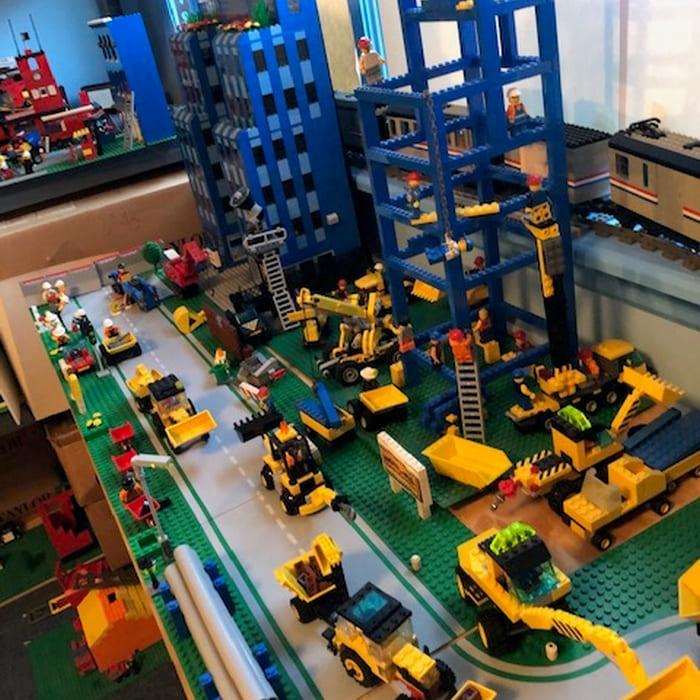
Didn’t get a chance to finish ballasting your tracks? (I didn’t start yet.) Put a work crew with hard hats out there with a pickup truck, a pile of ballast (1×1 squares, wedges, and round plates in greys, whites, and black) and maybe a group of ‘ties’ and you’ve solved your problem. A group of spare rails (the old 4.5 volt ones with individual grey rails) and ‘lumber’ to stack the tracks is another variation. And you don’t need a full circle of track for such a display (CTT, May, 2019). You can take it still further. There are/were special MOW (Maintenance of Way) train cars with crew cars, cranes, supply cars, a hopper of ballast, etc. I would probably create a short turnout track just to install such a permanent scene.
Several LEGO builders have the frame for a private house (typically 1×8 tan plates) with workers and supplies nearby. Others have the ‘girders’ for a multi-story building in place, with a construction crane, cement trucks, and lots of hard hats. Tools, wheelbarrows, and skids all add to the scene.
Much harder to build out of LEGO, I think, are old, dilapidated buildings. If you want to try, the March, 2010 issue of MR has a story about building an abandoned, falling apart barn. Another has a story of modeling torn up old tracks. Many towns have built walking and biking trails along old railroad right of ways. Scrap yards are popular on railroads, but I think depicting junk in LEGO is difficult. A small crane, a little shed for an office, and maybe a pickup or dump truck would be part of the scene. I’d try a half of a car, some technic beams, and some tires, among other things, with a fence surrounding the mess. A broken ladder, a little oil tank, maybe a telephone pole, and weeds would add to the scene (CTT, September, 2014).
WATER-RELATED LEGO CITY PLANNING
Every model railroader seems to think water is a great idea on a layout. (That’s why LEGO makes blue baseplates.) But what kind of water?
- A little watering hole on your farm?
- A nice sized pond or lake, maybe in a park?
- A creek or stream that flows through part of town, and then maybe off the layout?
- A river that is fairly large and leads off the layout?
- A canal or man-made channel, perhaps with a dam?
- All of the above?
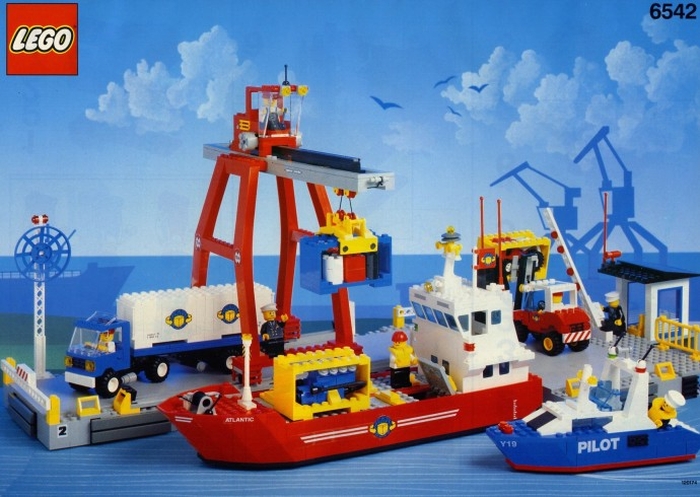
The differences are not just in size, but in the kind of boats on your waterway. A marina for small pleasure boats probably doesn’t belong right next to a dock area that has big freighters, some cranes, and maybe a train track. (#6542 LEGO Town Launch & Load Seaport, or the #4514 LEGO World City Cargo Train, for example.) The message of model railroading, over and over again, is context.
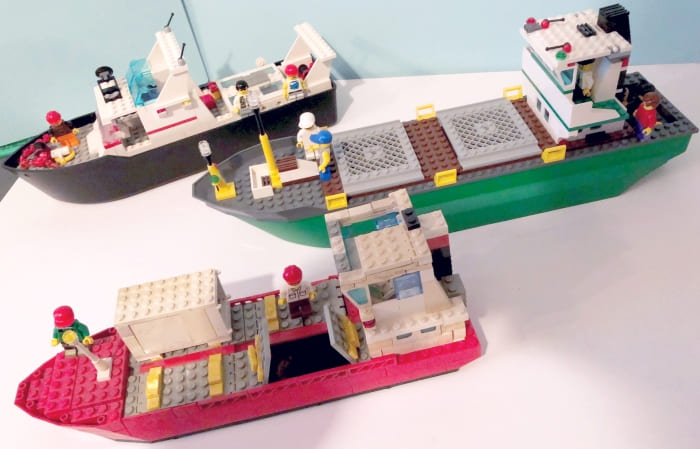
One woman built a harbor railroad, including a car float, on a two foot wide shelf (MR, March, 2009). Another person built a detailed model of Jones Island (Milwaukee) including a fish dock, a coal dock, and a separate trolley line (MR, April, 2009). Still another modeled a saltwater port (MR, September, 1997 and February, 2010). Others have built rivers with dams, and water flowing over it (MR, May, 2010).
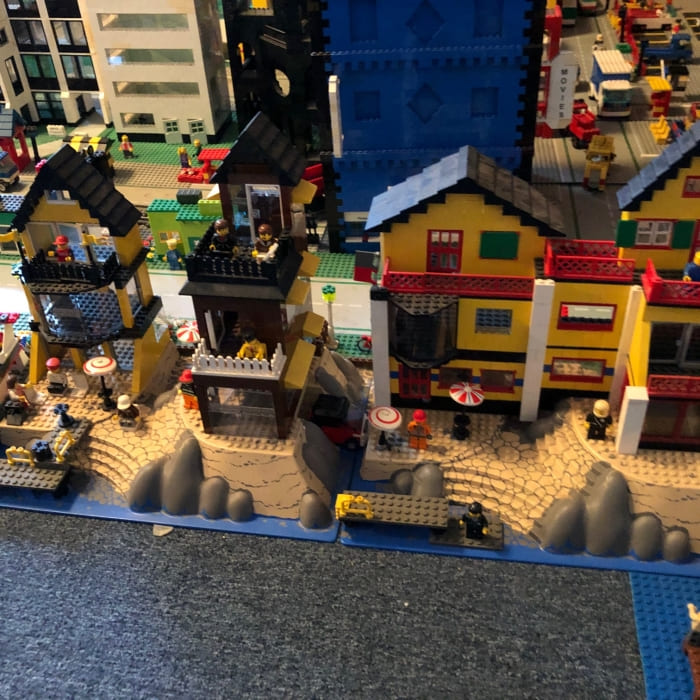
Several have built towering waterfalls starting close to the ceiling of their layout rooms. For LEGO, you can begin with a blue baseplate and then add as much as you want. Examples include translucent blue plates, waves, foam around and trailing a speeding boat, or a border of sand or rocks. A modeler came up a way of a boat moving on a lake in a figure eight pattern without any apparent engine or track (CTT, March, 2019).
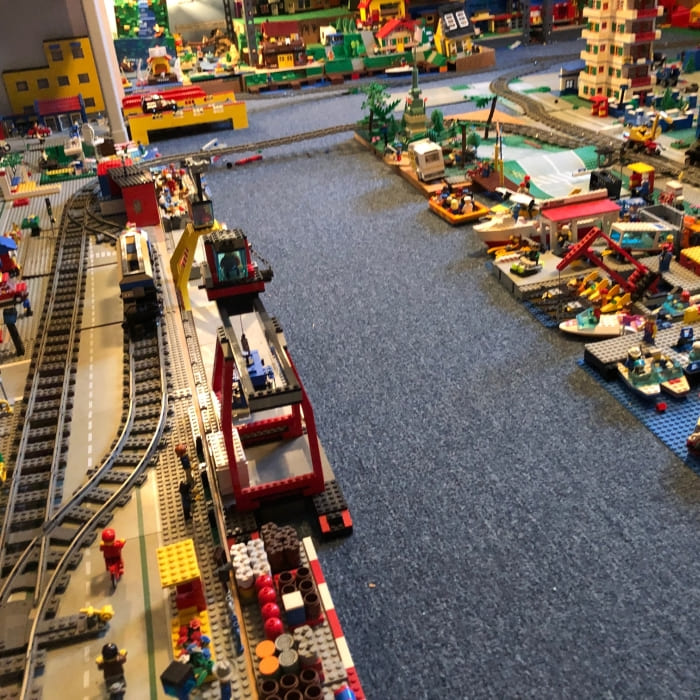
Water is almost always a good excuse for a bridge. And there are car bridges and train bridges and even tiny pedestrian bridges that might take you over a small creek in a park. Don’t ignore a pedestrian bridge over train tracks. Look at the most recent #75955 LEGO Harry Potter Hogwarts Express. How spectacular do you want the bridge? Money, time, and LEGO talent provide the answer. (One of my bridges is a combination of four bridges from the old #4852 LEGO Spiderman vs. Green Goblin set, which, by the way, included useful cable cars as well. But the roads are too narrow for current six-wide LEGO trucks. Another uses the old bridge from the #7900 LEGO City Heavy Loader truck. (Same problem.) Modelers often consider rivers and bridges the centerpiece of their layout.
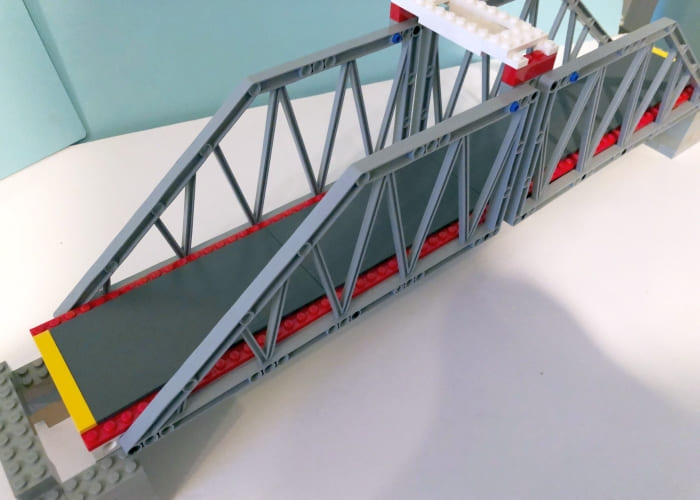
LEGO has made several lighthouses over the years, going back to the #6414 LEGO Paradisa Dolphin Point. They fit in nicely either on an island or at the edge of a peninsula. But you need scenery, maybe rocks, maybe even a small hill for the right look. There also many LEGO waterside buildings including the #6540 LEGO Town Pier Police and various coast guard and rescue bases that can be recreated with very few specialized parts.
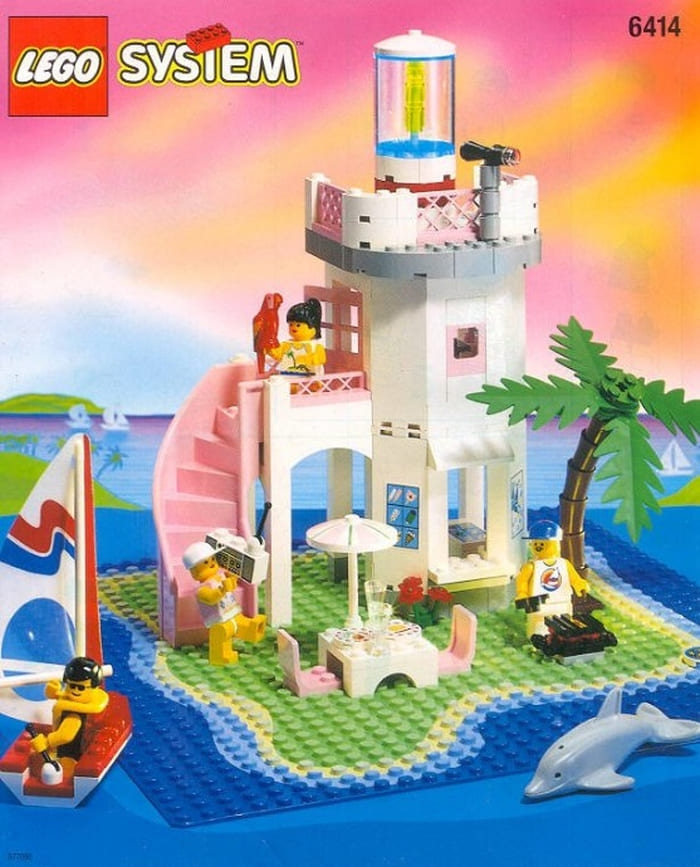
Water is a good excuse for a beach area, maybe a small cliff, possibly with a kid about to dive off, and maybe a couple of fellows in a rowboat fishing or just relaxing. A lurking shark adds to the drama. A painter seated by an easel and drawing the landscape is another nice touch. A corner under the bridge might be the place for a few hobos to camp out. A minifigure without his legs can pass for a person standing in waist deep water.
LEGO CITY PLANNING – BACKDROPS
Backdrops are a subject to itself, and relatively easy to accomplish. Your layout room should ideally be painted sky blue. But you can paint (or buy) backdrops of sky and clouds. (See, for example, Dr. McBrick.) Others paint mountains on their walls. Someone even painted backdrops on working window shades (MR, June, 2009).
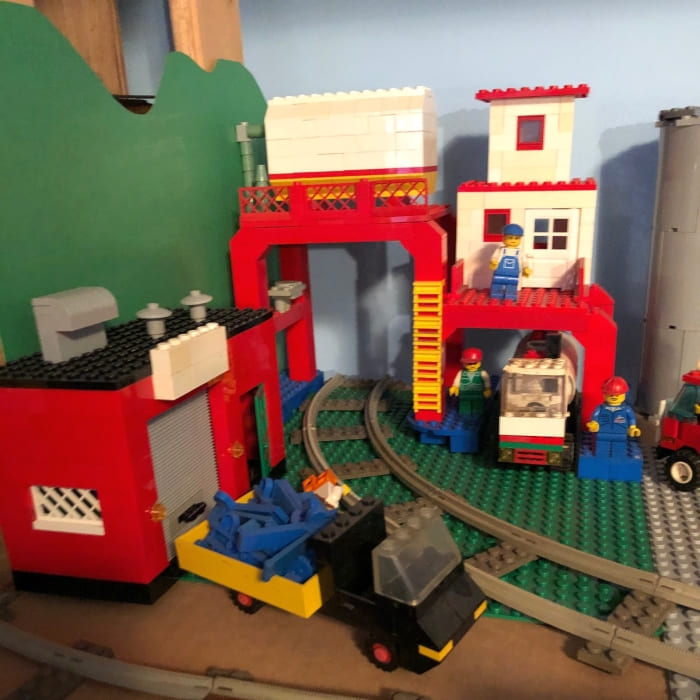
V,S. Roseman (CTT, May, 2016) outlines everything you need to do to give your LEGO layout depth. The difference between his before and after pictures are amazing. If possible, backdrops should be painted (or pasted) before the layout is put in place. Then comes background LEGO shell buildings. They are sold by several companies, but they are basically building fronts that are only two to eight studs deep.
People also take pictures of real and/or model buildings, size them on Photoshop, and paste them behind their layouts (see MR, July, 2010 and May, 2020 for two of many ideas). Try a progressive approach, using ever smaller photos to force the perspective. Fronts from much older LEGO sets that had four stud high doors and 2×2 windows placed at the back of your layout also adds depth. Then add cars, trees, fences, and small hills to hide the transition.
The ideal is to blend your layout into the scenery. I’ve seen farms and tree lines where you can’t tell where the scenery ends and the backdrop begins. The same is true for city scenes. I think the ultimate is a road that continues into the backdrop (MR, October, 2010). Look at BackdropWarehouse.com for lots of ideas.
LEGO CITY PLANNING – CONCLUSION
I hope you find at least a few ideas here that you can use in your own projects. Remember that MR notes that kids play games and allow for do-overs’. Golfers who take second tee shots call them ‘Mulligans‘. That’s what LEGO is meant for! Otherwise, we would all be using glue. I found doing a simple search is helpful for my own projects. I just wish I was a more talented builder.

Remember that these are just ideas taken from random – mainly old – train magazines. The Internet has thousands of LEGO creations at places like Flickr, Instagram, and Pinterest, but not necessarily the context. Two more collections of my ideas are on the way in future articles. Next time, I will focus on buildings and town scenes. But, maybe the best advice comes from a paraphrase of the old Frank Sinatra song: ‘you need to do it your way’. Your layout should be unique to you. Feel free to share your comments below. Happy building.
Mark H. Avery is a LEGO Town/City builder and collector for over 30 years with a layout of over 300 square feet. This article offers his personal insights and reflects his own personal opinions.
And you might also like to check out some of my previous articles:












I appreciate your articles. It reminds me of the old days when Lego was simpler.
Thanks.
Honestly, I liked the sets from 25 years ago better than today’s sets.
I very much agree that construction sites can add a lot of life to a moc. Even just putting up a guy on a ladder that makes him look like he is fixing something brings things to life.
Another way you can make backdrops is to slip some baseplates vertically behind your mocs (like on a shelf), and they tile it. You can do entire landscapes with sky, sun, clouds, mountains, distant cities, etc. It usually turns out cheaper and less parts intensive than narrow facades. Of course, drawing a backdrop is fine too. And you can also get old City posters on eBay with nice artwork.
I think there were some third party companies that produced custom printed baseplates. In my opinion, they were often more suited for backdrops than as horizontal bases…
Great idea!
I have a postal delivery service person delivering a package at a apartment building and a person answering the door to receive it. It’s not a big scene in a city but, I think a bunch of little scenes can make up the city as well. It makes it look like things are happening in a city. I do however, love the construction scene you have on display.
Thanks. I like the delivery man idea!
I’m jealous of your raised baseplates. Besides construction workers, another really dynamic scene is a building or vehicle on fire. You can add tons of the orange flames, minifigs running around panicked, firefighters fighting the flames, etc. 😀
The island baseplates with molded stones? They were only distributed in a single set, if I remember correctly. (A similar earlier mold lacked the added stones.)
I have a traffic accident scene instead. A car hits bicyclist. a ambulance , fire trucks and police cruisers are on the scene. Plus a police car chasing a getaway car . A typical City mess.
I just noticed your comment. I was thinking along similar lines.
Sounds good. The philosophy is to have many mini-scenes.
Another thing you can do is criminals running around and the police chasing them. Nothing shakes up a sleepy town better than a good police chase! 😀 😀
It’s interesting how much you can tell what era sets are from. Whenever I see pictures like these, I can clearly see they are from the 80s and before. When I think of Lego, red, blue, yellow, and other primary colors come mind. But they introduced so many new, subtle colors in the past decade or so. I wonder how this changes the perception of younger people.
One of the more humorous “stories” I have seen told in a LEGO train layout was a septic truck spraying sewage from a detached pumper hose.
Ouch! Now, that’s taking it too far! 😈
YUCK!
I keep debating whether to put a cemetery in my town. (possibly starting with the Harry Potter one.) But I don’t want to have to explain things to my younger grandchildren, so I haven’t built one yet.
Ahhh, with a cemetery you can introduce the whole fun topic of ghosts too! 😈
Seems like background details like trash cans, mailboxes, street lights, trees, etc. are important to creating scenes too. Any thoughts on that?
Yes, of course! However, I think here we were focusing more on more dynamic scenes. But yes, there are important to make a display realistic. 🙂
Love the idea of “action scenes”.
Growing up, my siblings and I would play (very carefully) in our father’s Legoland. We would play just like with any other toy that needed imagination. So we’d have car chases, fires, police cars responding to calls, construction sites, trains moving along the lines, etc.
While our father would sometimes be annoyed that we didn’t leave things the way they were, it gave the city a much more realistic, lived in feel.
Big fan of your articles. Keep them coming!